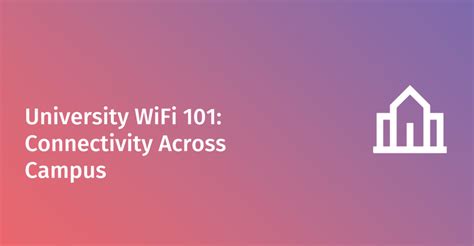Georgia State University’s (GSU) wireless network is an essential resource for students, faculty, and staff alike. With over 1,300 Wi-Fi access points spread across its sprawling campus, GSU ensures seamless connectivity for its community members. This article provides a comprehensive guide to accessing and optimizing the university’s Wi-Fi network, empowering users to leverage its full potential for academic and professional pursuits.

Connecting to the GSU Wi-Fi Network
To connect to the GSU Wi-Fi network, follow these simple steps:
- Locate a Wi-Fi Access Point: Use the GSU Wi-Fi map to identify the nearest access points on campus.
- Select the Network Name: Choose “GSU” from the available wireless networks on your device.
- Enter Credentials: Enter your GSU NetID and password to authenticate and connect to the network.
Optimizing Wi-Fi Performance
Once connected, there are several strategies you can implement to enhance your Wi-Fi performance:
- Choose the Right Frequency: GSU offers both 2.4 GHz and 5 GHz connections. The 5 GHz band provides faster speeds but has a shorter range, while the 2.4 GHz band offers better coverage but slower speeds. Select the appropriate frequency based on your proximity to the access point.
- Adjust Wireless Adapter Settings: Configure your wireless adapter to prioritize the “GSU” network and disable any power-saving modes that may hinder connectivity.
- Use Wi-Fi Analyzer Apps: Download a Wi-Fi analyzer app to identify areas with strong and weak signals. Use this information to reposition your device or move closer to an access point.
- Avoid Obstacles: Wi-Fi signals can be obstructed by physical barriers such as walls, furniture, and metal objects. Minimize obstructions between your device and the access point to maintain optimal signal strength.
- Minimize Device Usage: When experiencing congestion, limit your Wi-Fi usage to essential tasks. Close unused applications and avoid streaming videos or downloading large files.
Troubleshooting Wi-Fi Issues
If you encounter any connectivity problems, try the following troubleshooting steps:
- Restart Your Device: Restarting your device can resolve temporary glitches and refresh the Wi-Fi connection.
- Check for Network Outages: Visit the GSU IT Service Status page to confirm that there are no scheduled or ongoing network outages.
- Contact IT Support: If the problem persists, reach out to GSU’s IT Support for assistance. They can provide technical support and help resolve any network issues.
Maximizing Wi-Fi Potential for Research and Innovation
Beyond supporting daily academic and administrative tasks, GSU’s Wi-Fi network also serves as a platform for cutting-edge research and innovative applications.
Research and Data Analysis:
- Researchers leverage the high-speed Wi-Fi connections to access vast online databases, transfer large datasets, and conduct data-intensive computations.
- The university’s partnership with the Atlanta Supercomputing Center enables researchers to tap into advanced computing resources and perform complex simulations.
Immersive Learning Experiences:
- Wi-Fi technology facilitates the creation of virtual reality (VR) and augmented reality (AR) applications, enhancing student engagement and experiential learning.
- Faculty and students develop immersive educational content that transports learners to different time periods, cultures, or scientific environments.
Collaborative Projects:
- Wi-Fi connectivity enables real-time collaboration between students and researchers across different locations.
- Online collaboration tools, such as video conferencing and shared cloud platforms, facilitate seamless teamwork and project management.
Best Practices for Responsible Wi-Fi Usage
While GSU’s Wi-Fi network provides vast opportunities, it is important to use it responsibly to ensure a positive experience for all users:
- Respect Bandwidth Limits: Avoid excessive downloading or streaming to prevent network congestion.
- Practice Cybersecurity: Use strong passwords, enable two-factor authentication, and avoid accessing sensitive information over unsecure connections.
- Share the Network: Be mindful of others and limit your Wi-Fi usage during peak hours.
- Follow Digital Etiquette: Respect fellow users by avoiding loud conversations or video calls in shared spaces.
Tables for Enhanced Understanding
| Network Parameter | Value |
|---|---|
| Number of Access Points | 1,300+ |
| Wi-Fi Standards Supported | 802.11a/b/g/n/ac/ax |
| Speed (Maximum Theoretical) | 5 GHz: 1.3 Gbps |
| Security Protocols | WPA, WPA2, WPA3 |
| Troubleshooting Guide | Problem | Solution |
|---|---|---|
| Unable to connect to Wi-Fi | Check Wi-Fi settings, restart device | |
| Slow internet speed | Move closer to access point, optimize Wi-Fi settings | |
| Network outage | Check IT Service Status page, contact IT Support |
| Applications for Research and Innovation | Field | Application |
|---|---|---|
| Data Analysis | Bioinformatics | Process genomic and proteomics data |
| Immersive Learning | Archaeology | Explore ancient ruins and artifacts in VR |
| Collaborative Projects | Engineering | Share design and simulation models with remote teams |
| Responsible Wi-Fi Usage Guidelines | Key Principle | Action |
|---|---|---|
| Bandwidth Management | Respect usage limits | Limit downloads, stream videos during off-peak hours |
| Cybersecurity | Protect personal data | Use strong passwords, two-factor authentication |
| Sharing and Etiquette | Be considerate of others | Avoid excessive usage, follow digital etiquette |
Conclusion
Georgia State University’s Wi-Fi network is a vital resource that empowers its community to connect, learn, innovate, and contribute to the advancement of knowledge. By understanding the dynamics of the network, optimizing its performance, and using it responsibly, students, faculty, and staff can fully leverage its capabilities. As technology continues to evolve, GSU will continue to invest in its Wi-Fi infrastructure, ensuring that its community remains connected and at the forefront of digital innovation.
